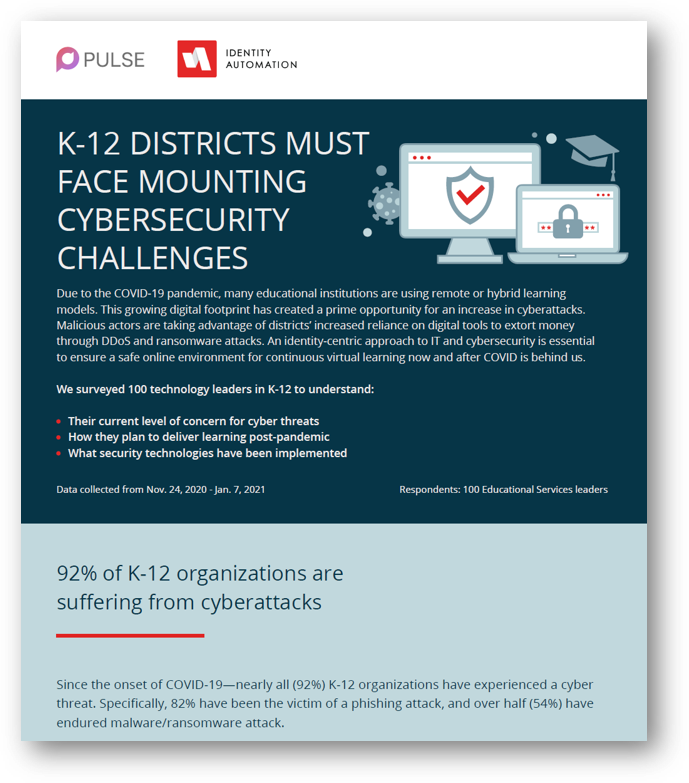
Due to the COVID-19 pandemic, many K-12 educational institutions are using remote or hybrid learning models. This growing digital footprint has created a prime opportunity for malicious actors to take advantage of districts’ increased reliance on digital tools.
An identity-centric approach to IT and cybersecurity is essential to ensure a safe online environment for continuous virtual learning now and after COVID is behind us.
We partnered with Pulse to survey 100 technology leaders in K-12 to understand their current level of concern for cyber threats, how they plan to deliver learning post-pandemic, and what security technologies have been implemented.
Let's dive right into our findings!
92% of K-12 organizations are suffering from cyberattacks
Since the onset of COVID-19—nearly all (92%) K-12 organizations have experienced a cyber threat. Specifically, 82% have been the victim of a phishing attack, and over half (54%) have endured malware/ransomware attack.
In addition, K-12’s digital footprint will continue to grow as 99% of districts plan to keep delivering some form of virtual learning post-pandemic, which means the increase in cyberattacks will likely not abate.
While nearly all (92%) of these organizations have suffered a cyberattack and 99% plan to continue providing virtual learning, less than half (42%) are moderately or significantly concerned that cyberattacks will continue to rise once COVID-19 restrictions are lifted, but they should be! The bigger the digital footprint, the bigger the target on schools’ backs.
Reliance on manual processes is exacerbating security risks
In order to protect digital resources, edtech leaders have focused on multi-factor authentication (88%). While 68% of edtech leaders report using automated access management, this typically involves writing custom scripts which can lead to operational challenges that impact instructional time. Only 9% have implemented identity lifecycle management.
As very few organizations have implemented identity lifecycle management to secure their edtech stack, almost all (99%) are still completing at least a quarter of their IT and security tasks manually.
According to 97% of edtech leaders, this reliance on manual tasks increases a K-12 organization’s exposure to security risks—such as the mounting cyberattacks they’ve experienced during COVID-19.
Low and decreasing security budgets leave K-12 organizations ill-equipped to protect themselves
Right now, the majority (96%) of respondents have allocated 10% or less of their budget towards securing access and protecting data.
Almost half (46%) of organizations plan to decrease their spend on secure student access and data protection—and an additional 35% don’t plan to increase their spend.
At Identity Automation, we understand that K-12 organizations have a mandate to drive innovation in support of hybrid learning. In addition, these organizations face increased cybersecurity threats, yet are required to work with reduced technology budgets.
Our identity lifecycle management solution, RapidIdentity Lifecycle, empowers K-12 districts to do more with less. RapidIdentity Lifecycle reduces staff and software costs, while providing a safe, seamless digital experience for all your staff, students, partners, and vendors by:
- Protecting student data and mitigating the risk of a data breach by actively managing each application or service containing sensitive data.
- Enhancing efficiency by automating account creation, changes, and deletion—at scale, seamlessly closing security gaps and keeping Active Directory and downstream systems up-to-date.
- Maximizing instructional time by providing your full educational ecosystem—students, faculty, parents, staff, contactors, applicants, vendors, subs, and more—with automated access to appropriate resources.


Comments